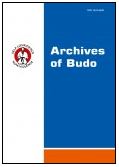2017, Volume 13
Effects of gradual weight loss on anaerobic capacity and muscle strength in elite taekwondo ITF athletes
Ewa Bakońska-Pacoń1, Wioletta Dziubek2, Gabriela Forgiel1, Eugenia Murawska-Ciałowicz1, Marek Zatoń1, Kazimierz Witkowski3
1Department of Physiology and Biochemistry, University School of Physical Education, Wrocław, Poland
2Department of Rehabilitation in Internal Diseases, University School of Physical Education, Wrocław, Poland
3Department of Martial Arts, University School of Physical Education, Wrocław, Poland
Author for correspondence: Ewa Bakońska-Pacoń; Department of Physiology and Biochemistry, University School of Physical Education, Wrocław, Poland; email: ewa.bakonska-pacon[at]awf.wroc.pl
Full text
Abstract
Background and Study Aim: Intentional reduction of body weight is a well-known and common practice among athletes, especially in weight category sports. The aim of this study was the effects of a 6-week gradual weight loss (GWL) program on anaerobic capacity, body composition and muscle strength of taekwondo athletes.
Material and Methods: The study included 9 men and 9 women practicing taekwondo ITF athletes (proficiency second dan). The following indicators were determined during the anaerobic capacity test: maximum power Pmax (W; W · kg−1), time to maximum power tPmax (s), time of maintenance power tmP (s), total work Wtot (J · kg−1) and fatigue index % FI. The list of determined body composition indicators included: relative content of fatty tissue (%FAT), lean body mass (LBM) and total body water (TBW). Moreover, we calculated body mass index BMI (kg · m−2) of the athletes. Concentration of lactate was determined in the arterialized blood from the finger pulp, obtained immediately prior to the warm-up and proper Wingate test, as well as 3 minutes post-exercise. Blood lactate concentration (La) was determined enzymatically using a LP400 Photometer (Dr Lange, Germany).
Results: After GWL, both men and women showed a significant decrease in body weight (p<0.05). Also the relative content of fatty tissue (% FAT) decreased significantly (p<0.05) in both men and women, by 2.99% and 1.69% on average, respectively. GWL resulted in changes in the analyzed indicators of anaerobic capacity. Maximum power (W) decreased significantly (p<0.05), by 82.10 and 11.78 in men and women, respectively. Following the GWL program, both women and men presented with significantly lower values of the peak torque and average power in dominant limbs tested at both angular velocities. However, the decrease in these indicators did not correlated significantly with maximum power determined during a Wingate test.
Conclusions: The GWL programs may exert beneficial effects as a method of weight control in taekwondo athletes if followed by an individualized control of training effects. Changes in body weight and composition, including a decrease in BMI, did not alter significantly the indices of anaerobic capacity.
Key words: training workloads, muscle balance, body composition, balanced diet, water balance, Wingate test




